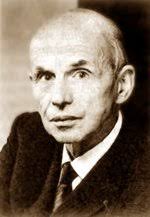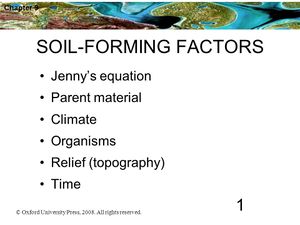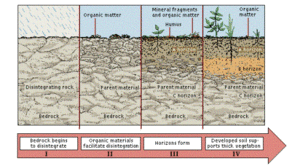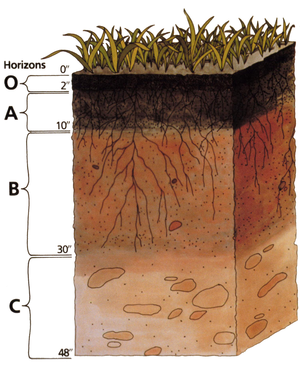Jenny Equation: Difference between revisions
m The LinkTitles extension automatically added links to existing pages (<a rel="nofollow" class="external free" href="https://github.com/bovender/LinkTitles">https://github.com/bovender/LinkTitles</a>). |
|||
| (18 intermediate revisions by 2 users not shown) | |||
| Line 1: | Line 1: | ||
== Origins == | == Origins == | ||
[[File:Jenny.png|thumb]] | [[File:Jenny.png|thumb]] | ||
The Jenny Equation was created by Hans Jenny to explain the [[soil|soil]] formation process. It was first internationally recognized when Hans Jenny published his book “Factors of Soil Formation” in 1941. The Jenny Equation is a formula used to help determine the properties of the soil such as fertility and mineral composition, as well as the [[organisms|organisms]] living within the soil and the chemical reactions that will occur around plant roots and the other organisms. | The Jenny Equation was created by Hans Jenny, one of the [[Founders of Soil Concepts|Founders of Soil Concepts]] to explain the [[soil|soil]] formation process. It was first internationally recognized when Hans Jenny published his book “Factors of [[Soil]] Formation” in 1941. The Jenny Equation is a formula used to help determine the [[properties|properties]] of the soil such as fertility and mineral composition, as well as the [[organisms|organisms]] living within the soil and the chemical reactions that will occur around [[plant roots]] and the other organisms. | ||
== Hans Jenny == | == Hans Jenny == | ||
| Line 7: | Line 7: | ||
[[File:Hans Jenny.jpg|frame|A photograph of Hans Jenny]] | [[File:Hans Jenny.jpg|frame|A photograph of Hans Jenny]] | ||
Hans Jenny was born in Switzerland in 1899. His college career started with the Swiss Federal Institute of Technology (Zurich) where he received a bachelor in agriculture in 1922. He later received degrees in chemistry and ion exchange reactions by 1927, also from Zurich. In 1936 he joined The University of California, Berkeley as a member of the faculty. His intensive education helped him formulate the Jenny Equation, which is S = f(cl, o, r, p, t, …). In this equation the “S” represents soil formation, "cl" is climate, "o" is organisms in the soil, "r" is relief such as the topography, “p” is the parent material, “t” is the time that takes place. He left the “…” in case something new was discovered or needed to be added later. | Hans Jenny was born in Switzerland in 1899. His college career started with the Swiss Federal Institute of Technology (Zurich) where he received a bachelor in [[agriculture]] in 1922. He later received degrees in chemistry and ion exchange reactions by 1927, also from Zurich. In 1936 he joined The University of California, Berkeley as a member of the faculty. His intensive education helped him formulate the Jenny Equation, which is S = f(cl, o, r, p, t, …). In this equation the “S” represents [[soil|soil]] formation, "cl" is climate, "o" is [[organisms|organisms]] in the soil, "r" is relief such as the topography, “p” is the parent material, “t” is the time that takes place. He left the “…” in case something new was discovered or needed to be added later. | ||
== Uses of Jenny Equation == | == Uses of Jenny Equation == | ||
The Jenny Equation helps determine the physical [[properties|properties]] of soil based on several independent factors. These factors are | The Jenny Equation helps determine the physical [[properties|properties]] of [[soil|soil]] based on several independent factors. These factors are from the [[pedogenesis|pedogenesis]] processes, which in this equation are climate, [[organisms|organisms]], topography, parent material, time, and any other factors that may apply. The Jenny equation is used to help design soil maps, which demonstrate a soil's contents and helps determine what it is useful for. | ||
[[File:Soil factors 1.jpeg|thumb|Factors that go into the Jenny equation]] | [[File:Soil factors 1.jpeg|thumb|Factors that go into the Jenny equation]] | ||
| Line 17: | Line 17: | ||
[[File:Soi eroision 2.gif|thumb|Soil erosion due to weathering]] | [[File:Soi eroision 2.gif|thumb|Soil erosion due to weathering]] | ||
Two of the most influential factors of climate are temperature and moisture. Temperature has a direct effect on the rate that chemical reactions can occur in the soil. The higher the temperature, the quicker the reactions will happen within the soil. Moisture also affects the rates of chemical reactions that can happen in the soil. Like with temperature, higher moisture levels increase the rates of chemical reactions. This will allow plants to grow faster, as well as allowing the bacteria and fungus to be more active. Decomposers are more efficient when the temperature and moisture levels are high. Rainfall also has the impact of weathering and erosion. This helps to break down the larger rocks and other soil particles into smaller pieces. | Two of the most influential factors of climate are temperature and moisture. Temperature has a direct effect on the rate that chemical reactions can occur in the [[soil|soil]]. The higher the temperature, the quicker the reactions will happen within the soil. Moisture also affects the rates of chemical reactions that can happen in the soil. Like with temperature, higher moisture levels increase the rates of chemical reactions. This will allow plants to grow faster, as well as allowing the bacteria and fungus to be more active. [[Decomposers]] and [[insects|insects]] are more efficient when the temperature and moisture levels are high. Rainfall also has the impact of weathering and erosion. This helps to break down the larger rocks and other soil particles into smaller pieces. | ||
== Organisms == | == Organisms == | ||
Main article: [[Organisms]] | Main article: [[Organisms]] | ||
The organisms in the soil also influence the soils processes and functions. The vegetation and animals have a significant role. Plants roots help to break up the soil by creating more surface area for water to seep into. This allows chemical reactions to occur here as plants excrete chemicals that help these chemical reactions to take place. These chemicals also attract bacteria and fungi, which allow them to help speed up the roots' ability to uptake nutrients as well as fend off harmful chemicals and organisms. | The organisms in the [[soil|soil]] also influence the soils processes and functions. The vegetation and [[animals]] have a significant role. Plants roots help to break up the soil by creating more surface area for water to seep into. This allows chemical reactions to occur here as plants excrete chemicals that help these chemical reactions to take place. These chemicals also attract bacteria and fungi, which allow them to help speed up the roots' ability to uptake nutrients as well as fend off harmful chemicals and organisms. [[Detritivores|Detritivores]] like, bacteria and fungi also can multiply and decompose detritus material more easily. Dead organisms in the soil allow for more nutrients to be available, in [[Nutrient Cycling|Nutrient Cycling]] for plant uptake after [[decomposition]] begins, which also enhances soil fertility. | ||
== Topography == | == Topography == | ||
[[File:Soil horizons 3.png|thumb|[[Soil Horizons]]]] | [[File:Soil horizons 3.png|thumb|[[Soil Horizons]]]] | ||
The next factor in the equation is topography. Topography is the slope of the land, whether there is a hill, valley, flat plain, or other meaningful change in elevation. The topography of the land is a significant factor for the moisture content of the soil. For example, a hill will have a lower moisture content because of increased runoff, which limits the amount of infiltration by water into the soil. A valley will have a very high moisture content because the amount of water that can go into the soil is higher, as the water will drain into this area and accumulate, and have more time to infiltrate. A plain will have a medium amount of moisture in the soil. The slope also affects the type of vegetation that can grow as there will be more moisture in some areas than others. Slopes are also more prone to soil erosion. | The next factor in the equation is topography. Topography is the slope of the land, whether there is a hill, valley, flat plain, or other meaningful change in elevation. The topography of the land is a significant factor for the moisture content of the [[soil|soil]]. For example, a hill will have a lower moisture content because of increased runoff, which limits the amount of infiltration by water into the soil. A valley will have a very high moisture content because the amount of water that can go into the soil is higher, as the water will drain into this area and accumulate, and have more time to infiltrate. A plain will have a medium amount of moisture in the soil. The slope also affects the type of vegetation that can grow as there will be more moisture in some areas than others. Slopes are also more prone to [[soil erosion]] than plains are. | ||
== Parent Material == | == Parent Material == | ||
The parent material of the soil is determined from what type of rock it is derived from. Igneous, metamorphic, or sedimentary rock break down and create different types of soil, whether it is sandy, silt or clay dominated soil. The breaking down of the soil increases the surface area which allows more reactions to happen, enhances the soil's water retention, and allows more organisms to be able to live within it. The parent material will also determine the mineral composition of the soil. For example, if a rock rich in phosphorous breaks down due to weathering, the soil that it creates will have a higher content of phosphorus. The minerals in the soil will affect the types of organisms and plants that can thrive in the soil. If a soil is darker colored, it is from a volcanic eruption; these are metamorphic rocks. Lighter soils are formed from igneous rocks. | The parent material of the [[soil|soil]] is determined from what type of rock it is derived from. Igneous, metamorphic, or sedimentary rock break down and create different types of soil, whether it is sandy, [[silt|silt]] or [[clay|clay]] dominated soil. The breaking down of the soil increases the surface area which allows more reactions to happen, enhances the soil's water retention, and allows more [[organisms|organisms]] to be able to live within it. The parent material will also determine the mineral composition of the soil. For example, if a rock rich in phosphorous breaks down due to weathering, the soil that it creates will have a higher content of phosphorus. The minerals in the soil will affect the types of organisms and plants that can thrive in the soil. If a soil is darker colored, it is from a volcanic eruption; these are metamorphic rocks. Lighter soils are formed from igneous rocks that have broken down. | ||
== Time == | == Time == | ||
Time is the next variable in the equation. The amount of time directly affects the weathering rates. As the time increases the more weathering can occur, which allows the parent material to break down further and create different minerals and smaller soil particles. Time also affects the amount of growth a plant will have and its interactivity with the soil, through roots and the chemicals released by them, as well as the uptake of nutrients. | Time is the next variable in the equation. The amount of time directly affects the weathering rates. As the time increases the more weathering can occur, which allows the parent material to break down further and create different minerals and smaller [[soil|soil]] particles. Time also affects the amount of growth a plant will have and its interactivity with the [[soil|soil]], through roots and the chemicals released by them, as well as the uptake of nutrients in the [[Nutrient Cycling|Nutrient Cycling]] system. | ||
== Additional Factors == | == Additional Factors == | ||
Hans Jenny also left room in the equation for any other factors that he could not think of or had not yet been discovered. However, nothing has been added to Hans Jenny’s equation since it was originally written in 1941, as no new factors that influence the way soils react with their environments have yet been found. | Hans Jenny also left room in the equation for any other factors that he could not think of or had not yet been discovered. However, nothing has been added to Hans Jenny’s equation since it was originally written in 1941, as no new factors that influence the way [[soil|soils]] react with their environments have yet been found. | ||
== References == | == References == | ||
texts.cdlib.org/view?docId=hb7c6007sj;NAAN=13030&doc.view=frames&chunk.id=div00028&toc.depth=1&toc.id=&brand=calisphere. | |||
“(u). Soil [[Pedogenesis]].” 7(v) Climate Classification and Climatic Regions of the World, www.physicalgeography.net/fundamentals/10u.html. | |||
www.researchgate.net/publication/280237646_Predicting_soil_map_using_Jenny_equation. | |||
“Smithsonian National Museum of Natural History.” The Age of Oxygen, forces.si.edu/soils/02_01_04.html. | |||
Revolvy, LLC. “‘Clorpt’ on Revolvy.com.” Trivia Quizzes, www.revolvy.com/main/index.php?s=Clorpt. | |||
http://www.innspub.net/wp-content/uploads/2013/12/JBES-Vol3No12-p125-134.pdf | |||
Latest revision as of 13:06, 10 May 2023
Origins

The Jenny Equation was created by Hans Jenny, one of the Founders of Soil Concepts to explain the soil formation process. It was first internationally recognized when Hans Jenny published his book “Factors of Soil Formation” in 1941. The Jenny Equation is a formula used to help determine the properties of the soil such as fertility and mineral composition, as well as the organisms living within the soil and the chemical reactions that will occur around plant roots and the other organisms.
Hans Jenny

Hans Jenny was born in Switzerland in 1899. His college career started with the Swiss Federal Institute of Technology (Zurich) where he received a bachelor in agriculture in 1922. He later received degrees in chemistry and ion exchange reactions by 1927, also from Zurich. In 1936 he joined The University of California, Berkeley as a member of the faculty. His intensive education helped him formulate the Jenny Equation, which is S = f(cl, o, r, p, t, …). In this equation the “S” represents soil formation, "cl" is climate, "o" is organisms in the soil, "r" is relief such as the topography, “p” is the parent material, “t” is the time that takes place. He left the “…” in case something new was discovered or needed to be added later.
Uses of Jenny Equation
The Jenny Equation helps determine the physical properties of soil based on several independent factors. These factors are from the pedogenesis processes, which in this equation are climate, organisms, topography, parent material, time, and any other factors that may apply. The Jenny equation is used to help design soil maps, which demonstrate a soil's contents and helps determine what it is useful for.

Climate

Two of the most influential factors of climate are temperature and moisture. Temperature has a direct effect on the rate that chemical reactions can occur in the soil. The higher the temperature, the quicker the reactions will happen within the soil. Moisture also affects the rates of chemical reactions that can happen in the soil. Like with temperature, higher moisture levels increase the rates of chemical reactions. This will allow plants to grow faster, as well as allowing the bacteria and fungus to be more active. Decomposers and insects are more efficient when the temperature and moisture levels are high. Rainfall also has the impact of weathering and erosion. This helps to break down the larger rocks and other soil particles into smaller pieces.
Organisms
Main article: Organisms
The organisms in the soil also influence the soils processes and functions. The vegetation and animals have a significant role. Plants roots help to break up the soil by creating more surface area for water to seep into. This allows chemical reactions to occur here as plants excrete chemicals that help these chemical reactions to take place. These chemicals also attract bacteria and fungi, which allow them to help speed up the roots' ability to uptake nutrients as well as fend off harmful chemicals and organisms. Detritivores like, bacteria and fungi also can multiply and decompose detritus material more easily. Dead organisms in the soil allow for more nutrients to be available, in Nutrient Cycling for plant uptake after decomposition begins, which also enhances soil fertility.
Topography

The next factor in the equation is topography. Topography is the slope of the land, whether there is a hill, valley, flat plain, or other meaningful change in elevation. The topography of the land is a significant factor for the moisture content of the soil. For example, a hill will have a lower moisture content because of increased runoff, which limits the amount of infiltration by water into the soil. A valley will have a very high moisture content because the amount of water that can go into the soil is higher, as the water will drain into this area and accumulate, and have more time to infiltrate. A plain will have a medium amount of moisture in the soil. The slope also affects the type of vegetation that can grow as there will be more moisture in some areas than others. Slopes are also more prone to soil erosion than plains are.
Parent Material
The parent material of the soil is determined from what type of rock it is derived from. Igneous, metamorphic, or sedimentary rock break down and create different types of soil, whether it is sandy, silt or clay dominated soil. The breaking down of the soil increases the surface area which allows more reactions to happen, enhances the soil's water retention, and allows more organisms to be able to live within it. The parent material will also determine the mineral composition of the soil. For example, if a rock rich in phosphorous breaks down due to weathering, the soil that it creates will have a higher content of phosphorus. The minerals in the soil will affect the types of organisms and plants that can thrive in the soil. If a soil is darker colored, it is from a volcanic eruption; these are metamorphic rocks. Lighter soils are formed from igneous rocks that have broken down.
Time
Time is the next variable in the equation. The amount of time directly affects the weathering rates. As the time increases the more weathering can occur, which allows the parent material to break down further and create different minerals and smaller soil particles. Time also affects the amount of growth a plant will have and its interactivity with the soil, through roots and the chemicals released by them, as well as the uptake of nutrients in the Nutrient Cycling system.
Additional Factors
Hans Jenny also left room in the equation for any other factors that he could not think of or had not yet been discovered. However, nothing has been added to Hans Jenny’s equation since it was originally written in 1941, as no new factors that influence the way soils react with their environments have yet been found.
References
texts.cdlib.org/view?docId=hb7c6007sj;NAAN=13030&doc.view=frames&chunk.id=div00028&toc.depth=1&toc.id=&brand=calisphere.
“(u). Soil Pedogenesis.” 7(v) Climate Classification and Climatic Regions of the World, www.physicalgeography.net/fundamentals/10u.html.
www.researchgate.net/publication/280237646_Predicting_soil_map_using_Jenny_equation.
“Smithsonian National Museum of Natural History.” The Age of Oxygen, forces.si.edu/soils/02_01_04.html.
Revolvy, LLC. “‘Clorpt’ on Revolvy.com.” Trivia Quizzes, www.revolvy.com/main/index.php?s=Clorpt.
http://www.innspub.net/wp-content/uploads/2013/12/JBES-Vol3No12-p125-134.pdf